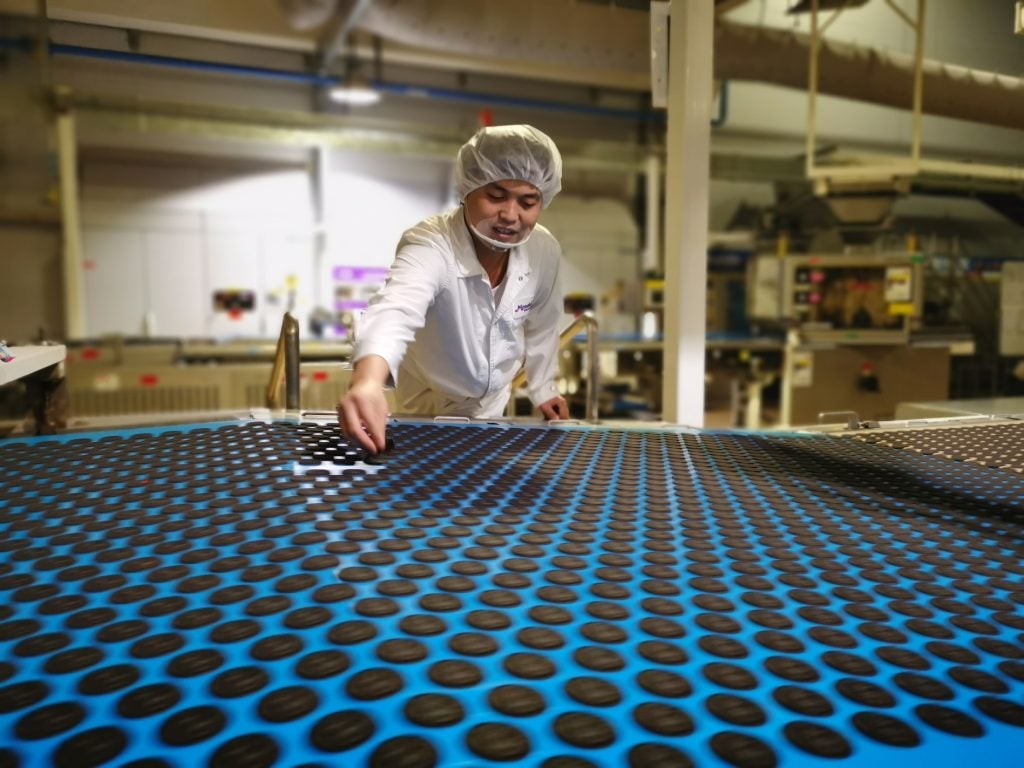
As senior director and global lead for digital R&D at Mondelez International, Joe Manton is central to the snacks giant’s efforts to use digital technology to help its research and development.
Manton joined the Cadbury and Oreo maker in 2019 and one of his first tasks was to look at how the company could harness artificial intelligence in its R&D processes.
Just Food sat down with Manton to hear what Mondelez has learned so far, how its R&D staff feel about using AI and the potential he sees for the business.
Just Food: How is Mondelez using the technology in its NPD?
Joe Manton: We started out with three test and learns, exploring to learn how AI could help us. One was: could we leverage AI against vast quantities of historical data? Where we think we’ve got a lot of historical knowledge about something, can it leverage that to take us forward?
Two, where we don’t have much [data] at all. We might have some ideas, something nearby, but this is new product development. The third was where something like the transient aspects of the consumer experience is important. Think about chewing gum. It changes texture over time, flavour changes over time. Can AI help us formulate for that entire experience? We started off with those three. On new product development, in particular, we had great success.
JF: When did the company start that work?
JM: 2019. It was one of the first projects we picked up. We are definitely behind some and we are ahead of others.

US Tariffs are shifting - will you react or anticipate?
Don’t let policy changes catch you off guard. Stay proactive with real-time data and expert analysis.
By GlobalDataJF: What was the corporate spark to look at AI in R&D?
JM: It’s part of the reason I am here. To my knowledge, it started with [Mondelez’s] R&D leadership who actually asked themselves: ‘How are we going to maintain our world-class reputation as an R&D organisation?’ They put a lot of effort into understanding how others who have a similar reputation are moving forward.
And, without question, those that excel were leveraging digital to a far greater extent. I say digital rather than AI because AI is only one part. In those four and a half years, it’s gone from ‘Let’s explore. We should be doing something. What might it look like?’ to digital being thread through the company’s vision and strategy in everything that we do. It started with that spark but it’s well-recognised as necessity.
JF: What did Mondelez actually learn in those three areas?
JM: Where we have vast quantities of historical data, we learned that there’s a difference between quality and quantity. We have now initiated a data programme – particularly in R&D but, again, this will be broader – to get our data into a far better shape and, predominantly, that is the implementation of data governance so that we truly start to treat our data as a valuable asset, rather than a by-product of what we do.
JF: What kinds of historical datasets were being crunched?
JM: In R&D and the bits we were actually leveraging, it is from a concept – which is put in front of a product developer – then the recipes and ingredients that are put together in an attempt to speak to that concept. Then we go through a series of internal and external consumer testing to really explore how that’s going to delight the consumer and ultimately pick the one that goes to market. So, in some cases, a lot of this historical data existed and that’s where we started on that one.
JF: Is Mondelez hoping that harnessing AI to look at historical sets of data will help inform its NPD strategy when it’s looking at developing new products or changing recipes?
JM: Well, historical data is either a good springboard for something very new – it tells you what you know about what you’ve done, which can be a good input into something new – or helps you understand where you can take what you’ve already been doing.
But what we’ve found is that – with the way we term it and talk about it internally – is it breaks the imposed constraints on human creativity. Businesses are real, right, of course, and a project timeline exists and a budget exists. As a concept comes to a product developer, they’re given a slot in a programme. ‘You’ve got this much time and here’s the budget.’ And, if they don’t hit that, they’re going to slow everything toward market.
So, whilst the new concept might start to have their mind spark with ideas on what could be possible, they need to deliver, so they’ll tend to lock down what could probably stay constant and what they know and only open up a couple of variables to explore. The power we’ve seen with AI is you can still provide a similar-sized decision set but the influence is much broader.

JF: On the other two ‘test and learn’ areas: what’s happened there?
JM: On the second one, so as we’ve started to explore this whole digital space, AI in particular, folks have not been immune to, just like everyone else, a certain level of fear. ‘AI is going to take our jobs’, right? But what we have found, as we put this capability in people’s hands, particularly on new product development, is it doesn’t replace. It augments. You still need the developer and their expertise. AI can spit out columns of garbage sometimes. It needs to be trained. If you haven’t got the historical data against which to train it, then it is a live person who’s training it probably with a panel around them. It’s iterative still. That’s the main learning there.
On the transient aspects, we lacked enough data, so, as of yet, we haven’t been successful in that space. We concentrated on the success we’ve had in the other two rather than worry about that for now. We’ll come back and pick it up probably.
JF: Are you able to provide tangible examples of a product where using AI in R&D has been of specific use?
JM: There’s no product on the shelf that is a sole output of this for a couple of reasons. One is 2019 might feel like a while ago but it’s still relatively new for us. We have had success out of that approach but other business decisions have been made. Quite often you decide to explore these things but you make other choices. ‘Recyclable packaging for this product range is more important than bringing out a new flavour. Let’s switch resources and bring that to market.’ A few things like that have happened.
Where it has tangibly helped is actually as part of the overall toolset because we’ve been able to include various parameters like cost. Before it has been a very linear process: here’s the concept, here’s some potential recipes, go through an internal panel, find some, see what the consumers like.
AI has not delivered one thing on the shelf all by itself – and I don’t think it ever will.
How much is each of these going to cost? It doesn’t quite work, so let’s go back and let’s see what we can change. We’re able to bring cost in very early. AI has not delivered one thing on the shelf all by itself – and I don’t think it ever will. It augments our developers. Has it contributed to some of the decisions of current initiatives? Yes, it has.
JF: Has it made the NPD process at Mondelez less lumpy, more efficient?
JM: I would say we’re on our way to a place where I think we can get. We’re not quite there yet. Today, it’s linear and it’s linear because the steps are driven by the next investment level. Running a consumer test is expensive and it’s time-consuming. You want to give yourself as good a chance as possible to be successful, so you do some pre-steps internally and, before that, you do some pre-steps on the bench.
These linear steps are driven by these investment steps, each one necessitating the other, and I think we can get to a simultaneous decision space. All of these things can be considered at the same time. You can bring the consumer right into the centre of the decisions you’re making. More speed to market I would say and therefore your ability to be able to respond to market shifts, trends, consumer needs, wants far more rapidly than today.
JF: Are there tasks you perhaps may have expected AI to be able to help you to do now that it can’t yet?
JM: My answer might be slightly different. I wish we could make faster progress. I think we’re exploring all the right areas. There are more. We have to make choices to be effective. I wish we could be further down the journey and at the end of things. The fact is these journeys are learning journeys and, by definition, it takes time, because there are so many components to learn. There’s the technical aspect, there’s the data aspect, there’s the cultural aspect. They’re all connected.

JF: On the cultural aspect, AI has become a hot topic across industries, even society. There will be many employees at businesses looking at AI who are concerned about what it could mean for their own jobs. What feedback have you had at Mondelez?
JM: There’s feedback where people will openly tell you what they think and then there’s your read of the situation and the level of adoption and things. There’s definitely fear and concern there just because everywhere around you read about how AI is going to take everyone’s jobs.
I will say I’m not the only one who is a little – frustrated is the wrong word – who wish we could move faster. There are folks within the development community, the real early adopters, who wish we were doing this already.
People are never comfortable with change. Any form of change is always going to have some fear associated with it. If you look back at other industrial revolutions, things have changed but, generally, new types of jobs have been created. Why would this be any different?
AI frees up people’s capacity to get to the fun stuff.
JF: I was going to ask if you think it’s inevitable there are some R&D roles that one day might be replaced by the further development of AI?
JM: Anything’s possible. What we’re seeing is the efficiency benefits spread across multiple individuals. There’s not one person who does that one thing all day every day, that if you replace it, they go away. It’s components of people’s work and, honestly, it’s mainly the stuff that bogs people down. We’re growing as a company, so we have enough places for people to flow to these growth areas. If you look forward, it frees up people’s capacity to get to the fun stuff, the more interesting work, the more challenging work. We haven’t seen anything to contradict that yet. I’d be surprised if thousands of people march out the door because AI comes in but who am I?
JF: What can’t AI do now in your area that you expect it to be able to do in one, two, three years?
JM: There are many things it’s got potential to do that we’re exploring that it probably can do to some extent. It’s how well it can do it. We care about things from the field all the way to the shelf and there are aspects of every part of this, you look at what’s going on in agri-tech, ingredient sourcing and supply chain resilience, how you can actually embed that not only just looking at the supply chain itself but in your formulations. It’s already capable of doing elements of most things where people are required to assimilate data. It’s mainly assimilating lots of inputs back to the new product development space. The constraints on human creativity, people tend to lock down things and make problems solvable within a timeframe and a size. Wherever these decisions take place, from what I’ve seen, AI has the potential to keep the decision space the same but I’ll have far more things to be considered. You can apply that anywhere.
JF: Where is Mondelez exploring the further potential of AI in R&D?
JM: We’re continuing in the product development space. Just like everyone, ChatGPT has inspired people. Everyone has an idea of how it can be used to make their lives better, like, ‘why do you have to keep writing these reports? Can ChatGPT do it for me?’
I do want to be kind of careful what I say but definitely in our sourcing of ingredients from field forward, in our ability internally around product development – it’s not always just ‘new’ – and how we enable it to augment our developers and enrich that decision space.
We are also looking at using it in automation, which is more of an efficiency play but people themselves are tending to put up their hand saying ‘Hey, can we have some help here? This is a great idea. I want this to be gone. Can’t it do this?’
JF: You seem an advocate for AI’s use. You don’t seem to have any fears yourself.
JM: No, I don’t have fear. No, I don’t think so. Overall, there’s a lot of fear that it might become too powerful and take over. Good luck to it! I see it being helpful. At the moment. Maybe I’ve got blinkers on. There are definitely areas – responsible AI and so on – [and] the thing I would say is maybe I’m a little less sensitive to it. We don’t deal with any personal information in the R&D space. We’re dealing with hard, scientific data. Maybe if we’re dealing with people then you’d have to be a lot more careful, rigorous and responsible. At the moment, I see the potential for lots of benefit and, as I say, people themselves see it, too. I’m very positive about it.
Read more on Just Food: Generative AI – beyond the hype


